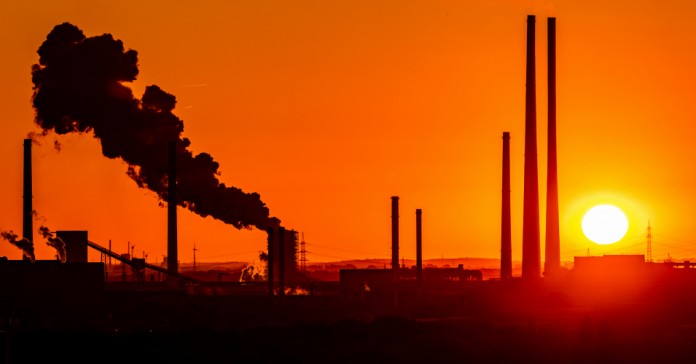✫✫✫
Atmospheric CO2 Nears Level Not Seen in 15 Million Years
Jessica Corbett
As a United Nations agency released new climate projections showing that the world is on track in the next five years to hit or surpass a key limit of the Paris agreement, authors of a new study warned Thursday that increasing carbon dioxide in the atmosphere is nearing a level not seen in 15 million years.
For the study, published in the journal Scientific Reports, researchers at the University of Southampton in the United Kingdom examined CO2 levels during the Late Pliocene about three million years ago “to search for modern and near future-like climate states,” co-author Thomas Chalk explained in a series of tweets.
“A striking result we’ve found is that the warmest part of the Pliocene had between 380 and 420 parts per million CO2 in the atmosphere,” Chalk told the Guardian. “This is similar to today’s value of around 415 parts per million, showing that we are already at levels that in the past were associated with temperature and sea-level significantly higher than today.”
When CO2 levels peaked during the Pliocene, temperatures were 3ºC to 4ºC hotter and seas were 65 feet higher, the newspaper reported. Chalk said that “currently, our CO2 levels are rising at about 2.5 ppm per year, meaning that by 2025 we will have exceeded anything seen in the last 3.3 million years.”
“We are burning through the Pliocene and heading towards a Miocene-like future,” warned co-author Gavin Foster, referencing a period from about 23 to 5.3 million years ago. It was during the Miocene, around 15 million years ago, when “our ancestors are thought to have diverged from orangutans and become recognizably hominoid,” the Guardian noted.
Reporting on the study elicited concern and calls for action from environmentalists and advocacy groups.
“Every kilo of CO2 we emit is one we have to sequester later, provided the food doesn’t run out first,” tweeted Extinction Rebellion Finland, urging the international community to #ActNow.
Nathaniel Stinnett, executive director of the U.S.-based Environmental Voter Project, also responded to the report on Twitter, saying, “Big Oil and Gas are killing us.”
A new report released Thursday by the U.N.’s World Meteorological Organization (WMO) about global temperatures likely coming in the next five years provoked similar alarm and demands.
“It’s still not too late to avoid the worst effects of the #ClimateEmergency. But governments need to act NOW,” declared Greenpeace, pushing for a #GreenRecovery from the Covid-19 pandemic.
The WMO report projects that the annual global temperature is likely to be at least 1°C warmer than pre-industrial levels in each of the next five years. Although it is “extremely unlikely” the average temperature for 2020–2024 will be 1.5°C warmer than pre-industrial levels, WMO warned certain periods could hit that temperature.
Specifically, there is about a 70% chance that one or more months during those five years will be at least 1.5°C hotter than pre-industrial levels and about a 20% chance that one of the next five years will be at least that warm, according to WMO’s Global Annual to Decadal Climate Update, led by the United Kingdom’s Met Office.
In a statement Thursday, WMO Secretary-General Petteri Taalas also pointed to the coronavirus pandemic—which prompted global lockdowns that briefly caused planet-heating emissions to drop—as an opportunity to pursue bold recovery plans that incorporate policies that combat the climate crisis, such as rapidly transitioning to renewable energy worldwide.
“WMO has repeatedly stressed that the industrial and economic slowdown from Covid-19 is not a substitute for sustained and coordinated climate action,” Taalas said. “Due to the very long lifetime of CO2 in the atmosphere, the impact of the drop in emissions this year is not expected to lead to a reduction of CO2 atmospheric concentrations which are driving global temperature increases.”
“Whilst Covid-19 has caused a severe international health and economic crisis, failure to tackle climate change may threaten human well-being, ecosystems, and economies for centuries,” he continued. “Governments should use the opportunity to embrace climate action as part of recovery program and ensure that we grow back better.”
Taalas added that “this study shows—with a high level of scientific skill—the enormous challenge ahead in meeting the Paris agreement on climate change target of keeping a global temperature rise this century well below 2°C above pre-industrial levels and to pursue efforts to limit the temperature increase even further to 1.5°C.”
While some scientists and activists have criticized the 2015 Paris climate agreement as not ambitious enough, it is backed by nearly all nations on Earth. U.S. President Donald Trump began the one-year withdrawal process in November 2019 but former Vice President Joe Biden, the presumed Democratic presidential nominee, has vowed to rejoin the accord if he wins this year’s election.
✫✫✫
Updated Species Extinction List Signals ‘Urgent Action Needed to Save Life on Earth’
Jessica Corbett
The U.S.-based Center for Biological Diversity warned Thursday of the “urgent action needed to save life on Earth” in response to a new global assessment revealing that nearly 27% of over 120,000 analyzed plant and animal species are now threatened with extinction.
“This assessment shows that one in four mammals are facing extinction, and although we don’t prefer to think of ourselves as animals, we humans are mammals,” Tierra Curry, a senior scientist at CBD, said in a statement. “We have to take bold and rapid action to reduce the huge damage we’re doing to the planet if we’re going to save whales, frogs, lemurs, and ultimately ourselves.”
“We know what we need to do to end extinction,” she added. “At this point it’s a matter of political will to rapidly move away from fossil fuels, stamp out the wildlife trade, and overhaul the toxic ways we produce food. We really can do all of these things, but we need world leaders to stand up and do them.”
Curry’s comments came after the International Union for Conservation of Nature (IUCN) on Thursday announced an update to its Red List of Threatened Species, revealing that 32,441 of 120,372 assessed species are at risk.
Like Curry, IUCN experts demanded urgent global action in a statement announcing the update.
“This IUCN Red List update exposes the true scale of threats faced by primates across Africa,” said IUCN acting director general Grethel Aguilar. “It also shows that Homo sapiens needs to drastically change its relationship to other primates, and to nature as a whole.”
“At the heart of this crisis is a dire need for alternative, sustainable livelihoods to replace the current reliance on deforestation and unsustainable use of wildlife,” Aguilar continued. “These findings really bring home the urgent need for an ambitious post-2020 biodiversity framework that drives effective conservation action.”
Among other animals, the IUCN Red List now classifies 33 lemur species, the European Hamster (Cricetus cricetus), and the North Atlantic Right Whale (Eubalaena glacialis) as critically endangered.
In a separate Center for Biological Diversity statement focusing on the whales found along the East Coast of the United States and Canada, legal director Kristen Monsell declared that “entanglements and ship strikes are pushing these amazing animals to the brink of extinction.”
Jane Smart, global director of the IUCN Biodiversity Conservation Group, said that “the dramatic declines of species such as the North Atlantic Right Whale included in today’s IUCN Red List update highlight the gravity of the extinction crisis.”
While the Red List focuses on species for which there is enough information to assess conservation status, Thursday’s update follows a May 2019 report from the Intergovernmental Science-Policy Platform on Biodiversity and Ecosystem Services that warned human activities had pushed a million species to the brink of extinction.
“Saving the fast-growing number of threatened species from extinction requires transformational change, supported by action to implement national and international agreements,” said Smart. “The world needs to act fast to halt species’ population declines and prevent human-driven extinctions, with an ambitious post-2020 biodiversity framework which the upcoming IUCN Congress will help define.”
The post-2020 global biodiversity framework is expected to be finalized at the next meeting of the Conference of the Parties (COP 15) to the United Nations Convention on Biological Diversity (CBD), which will likely be held in China sometime in 2021. The event was initially scheduled for October but has been postponed because of the ongoing coronavirus pandemic.
A draft 10-year strategy released earlier this year included a call to protect 30% of the planet’s land and ocean by 2030. A recent analysis commissioned by Campaign for Nature found that achieving that 30% goal would not only help halt biodiversity loss, fight the climate crisis, and reduce the risk of future pandemics but also produce billions of dollars in economic benefits.
In January, CBD published Saving Life on Earth, a plan detailing how the United States can help lead the fight against the global extinction crisis by investing $100 billion to save at-risk species and help create 500 new national parks, wildlife refuges, and marine sanctuaries. The plan also calls for protecting 30% of U.S. lands and water by 2030, and 50% by 2050.
“Humans have never witnessed the profound level of wildlife losses unfolding in front of us right now,” Curry said when the center’s plan was released. “We are at a planetary turning point that calls for visionary action to save life on Earth. The solutions are within reach. We only need the courage and political will to make it happen.”
(Jessica Corbett is a staff writer for Common Dreams, a US non-profit news portal.)




